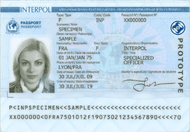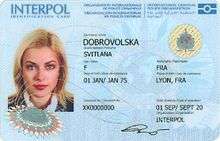Interpol Travel Document
| Interpol e-Passport Booklet | |
|---|---|
 The biographical data page inside the prototype Interpol e-Passport Booklet | |
| Date first issued | 13 October 2009[1] |
| Issued by | Interpol |
| Valid in | Interpol member countries |
| Type of document | Passport |
| Purpose | Identification |
| Eligibility requirements | Interpol officers travelling on official duty |
| Interpol e-Identification Card | |
|---|---|
 The front of an Interpol e-Identification Card | |
 The reverse of an Interpol e-Identification Card | |
| Date first issued | 7 November 2010[2] |
| Issued by | Interpol |
| Valid in | Interpol member countries |
| Type of document | Identity Card |
| Purpose | Identification |
| Eligibility requirements | Interpol officers travelling on official duty |
An Interpol Travel Document is a travel document issued to Interpol officers for travel to Interpol member countries. They are intended to reduce response times for personnel deployed to assist with transnational criminal investigations, major events or emergency situations by waiving normal visa requirements.[3]
The travel documents consist of an e-Passport Booklet and an e-Identification Card identifying the holder as an Interpol officer, granting them special immigration status when travelling on official Interpol duties to participating member countries.[4]
The Interpol Travel Document initiative proposal was approved by Interpol's Executive Committee in March 2009 and was unanimously ratified by Interpol member countries at the 79th Interpol General Assembly in Doha in November 2010.[5]
Physical appearance
The e-Passport Booklet contains 34 visa pages and a polycarbonate machine readable bio-data page. The cover is black with silver embossing on the front. The word "INTERPOL" in both Latin (INTERPOL) and Arabic (الإنتربول) script appears at the top, with the Interpol logo below. The word for 'Passport' then follows in all four official Interpol languages: English (PASSPORT), French (PASSEPORT), Spanish (PASAPORTE) and Arabic (جواز السفر). The biometric passport symbol appears at the bottom of the cover. The bio-data page features the holder's name, date and place of birth, photograph and signature, their job title, the passport number, the issuer code "XPO", and its issue and expiry dates. A machine readable strip runs along the bottom of the page.
The e-Identification Card is a light blue polycarbonate smartcard. The front features the Interpol logo overlaid with the holder's biographical data, photograph and signature, the document number and its expiry date. The reverse features the officer's job title, the card's issue date, the issuer code "XPO", and a machine readable strip.
Technical features
The Interpol travel documents were developed by the EDAPS Consortium[6] and Entrust, Inc.[7] The passport contains 29[8] security features including laser engraving and an electronic RFID chip storing the holder's biometric data, as well as holographic, micrographic and optical security elements.[9] Both travel documents meet the relevant ICAO/ISO standards and have been allocated the three-letter country code 'XPO'. The passports are produced in Kiev by EDAPS and can be printed and dispatched in less than two hours after an individual's personal data has been received.[8]
International recognition
Each participating member country decides whether to recognise either the e-Passport Booklet and/or the e-Identification Card and whether they need be used in conjunction with or without a valid national passport. The holder is then granted visa exemption, expedited visa processing or some other special visa treatment depending on the individual arrangement.
It was anticipated by Interpol that 100 members would have recognised the documents in time for Interpol’s 83rd General Assembly in Monaco in November 2014, which marked the 100th anniversary of the first International Criminal Police Congress.[10] This was achieved by the conclusion of the 83rd General Assembly.
As of July 2015, the travel documents are accepted in both its forms (e-Passport Booklet and/or e-Identification Card) to be used in conjunction with a valid national passport by 102 of Interpol's 190 member countries with a further 81 in the process of recognising them within the limits of their national laws.[11]
See also
References
- ↑ "Document: XPO-AS-01001". Public Register of Authentic Travel and Identity Documents Online (PRADO). The Council of the European Union. 16 April 2013. Retrieved 15 June 2013.
- ↑ "Document: XPO-BS-01001". Public Register of Authentic Identity and Travel Documents Online (PRADO). The Council of the European Union. 16 April 2013. Retrieved 15 June 2013.
- ↑ Bellknap, Kelly (13 October 2009). "Interpol Cops to Travel Without Visas". ABC News. Retrieved 20 March 2012.
- ↑ "The Interpol Travel Document Initiative - Information Leaflet". Interpol. December 2010. Retrieved 15 June 2013.
- ↑ "INTERPOL Travel Document initiative". Interpol. 2013. Retrieved 15 June 2013.
- ↑ "INTERPOL to set global standard in travel document security with new e-passport initiative". EDAPS Consortium. 21 September 2009. Retrieved 15 June 2013.
- ↑ "Entrust and INTERPOL Announce the Delivery and Use of Innovative Smartcard Credential Service". Entrust, Inc. 15 June 2010. Retrieved 15 June 2013.
- 1 2 Balueva, Tatiana (April 2010). "INTERPOL HAS RECEIVED E-PASSPORTS". Watermark Magazine. Retrieved 15 June 2013.
- ↑ "Interpol sets standard in electronic passports". Info Security Magazine. 23 September 2009. Retrieved 15 June 2013.
- ↑ Interview with Ralph Markert at Wise Media's sixth EMEA summit on YouTube
- ↑ "Official recognition from 102 member countries" (PDF). Interpol. Retrieved 6 July 2015.